As small as they may be, insects sting and can cause excruciating pain! Some may cause such severe pain that it lasts 24 hours without alleviation! Below, you’ll find a list of insects that sting ranked in order of most painful.
However, before discussing them in detail, we’d like to highlight that while most insect bites aren’t considered dangerous or poisonous, many can cause severe allergic reactions or secondary infections. Therefore, if you were stung by an insect, you should check with your doctor if additional medical care is required.
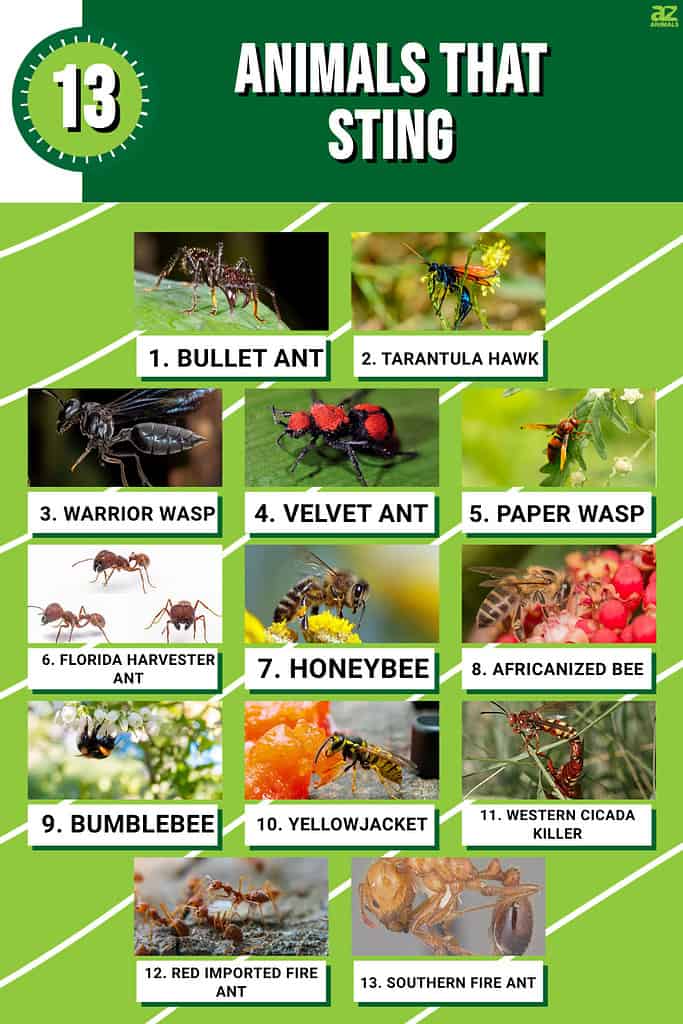
1. Bullet Ant
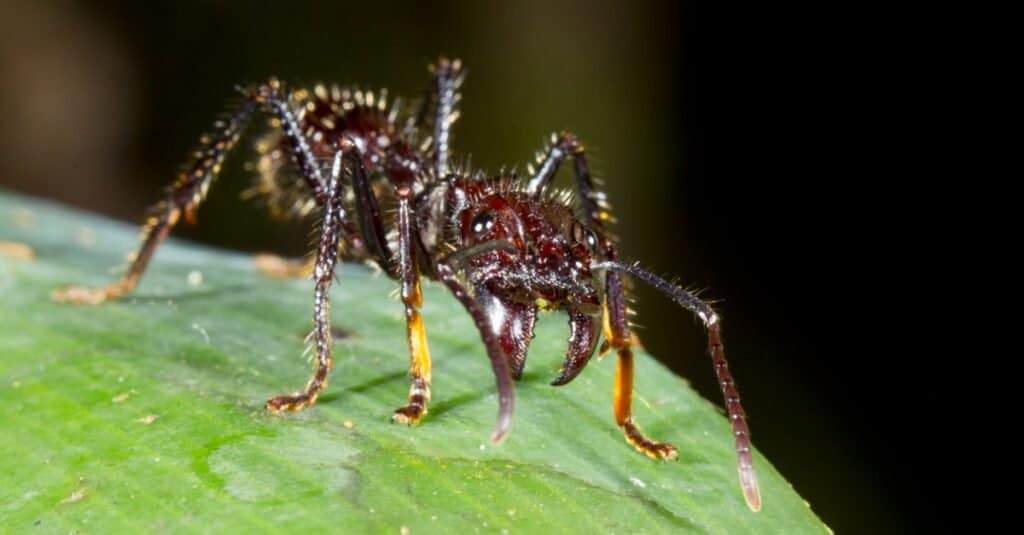
Bullet ant stings can cause edema, tachycardia, lymphadenopathy, and fresh blood in feces.
©iStock.com/Atelopus
| Bullet Ant | Details |
|---|---|
| Scientific classification | Paraponera clavata |
| Distribution | Humid lowland rainforests of Central and South America |
| Schmidt’s sting pain index | 4.0+ |
| Toxicity | Not considered poisonous but may cause allergic reactions |
Bullet ants get their name from their powerful sting. Some call them the Venezuelan hormiga veinticuatro, which translates as the “24-hour ant,” indicating that the pain from their sting lasts 24 hours. These ants are 0.7 – 1.2 inches long and have reddish-black bodies. While they aren’t considered aggressive, bullet ants may sting if they defend their nests or feel threatened.
Their sting is at the top of Schmidt’s sting pain index, ranking 4.0+. Some bullet ant victims said the pain felt like being shot and lasted up to 24 hours! Besides pain, bullet ant stings can cause edema (fluid retention), tachycardia (abnormal heart rate), lymphadenopathy (enlarged lymph nodes), and fresh blood in feces.
2. Tarantula Hawk
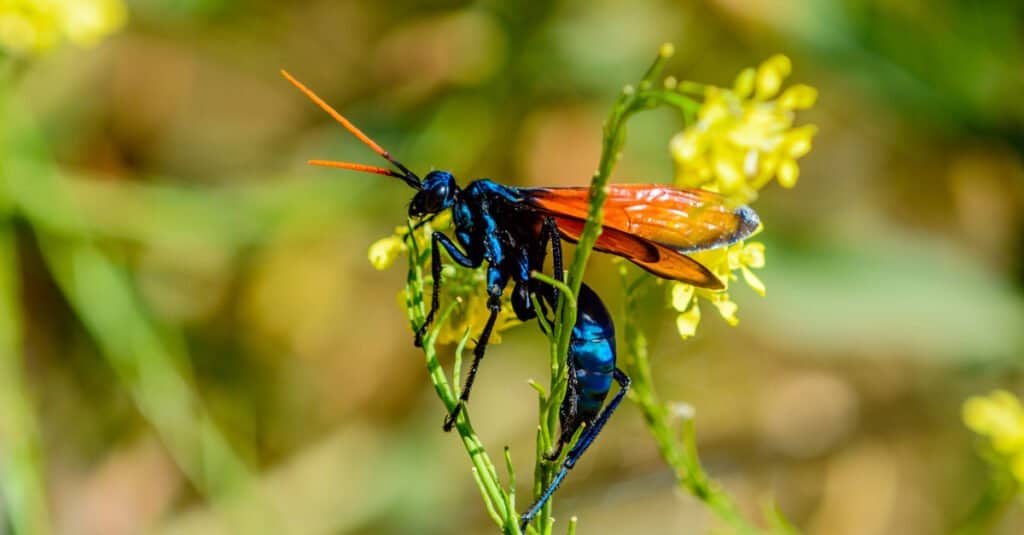
The tarantula hawk is a pepsine
spider wasp
that preys on tarantulas.
©Robert Briggs/Shutterstock.com
| Tarantula Hawk | Details |
|---|---|
| Scientific classification | Pepsis grossa |
| Distribution | United States, Mexico, and South America |
| Schmidt’s sting pain index | 4.0 |
| Toxicity | Not considered poisonous but may cause allergic reactions |
The Pepsis grossa, or the tarantula hawk, is a pepsine spider wasp that preys on tarantulas. Although it’s a small insect, reaching only around 2 inches, it has the second most-painful sting in the world.
The tarantula hawk population ranges throughout the United States, in Mexico, and northern South America. Their sting causes immediate excruciating pain. Luckily, the pain doesn’t last long, and the venom isn’t very toxic to humans. However, the area may remain red for around a week.
3. Warrior Wasp

Warrior wasps have black or dark blue bodies with metallic-like shades.
©iStock.com/ViniSouza128
| Warrior Wasp | Details |
|---|---|
| Scientific classification | Synoeca septentrionalis |
| Distribution | Central and South America |
| Schmidt’s sting pain index | 4.0 |
| Toxicity | Not considered poisonous but may cause allergic reactions |
Warrior wasps are scientifically called Synoeca septentrionalis. They have black or dark blue bodies with metallic-like shades. Warrior wasps aren’t very large, measuring around 0.79 inches long. These wasps live in Central and South America, where they inhabit the nests they build on trees. They’re considered aggressive and territorial insects.
Warrior wasps have the world’s third most-painful sting, described as torture or as if an electrical current goes through the stung area. The body may get hot, and the person may feel dizzy. The area becomes swollen and red, and it may itch. However, although the sting is extremely painful, it’s not particularly dangerous to humans unless it causes secondary infections or severe allergic reactions.
4. Velvet Ant

Velvet ants are divided into more than 7,000 species.
©Tarsal Claw/Shutterstock.com
| Velvet Ants | Details |
|---|---|
| Scientific classification | Dasymutilla klugii and Dasymutilla occidentalis |
| Distribution | The United States |
| Schmidt’s sting pain index | 3.0 |
| Toxicity | Not considered poisonous but may cause allergic reactions |
Velvet ants form the Mutillidae family and are divided into more than 7,000 species! However, not all velvet ants have such a powerful sting to reach high scores on Schmidt’s sting pain index.
Among thousands of species, the Dasymutilla klugii velvet ant rated 3.0 on Schmidt’s sting pain index. Another velvet ant species known to have an extremely painful bite is the Dasymutilla occidentalis, also called cow killer.
Velvet ant bites cause swelling and redness. At first, they’ll feel like a bee sting, but the pain will slowly increase. Moreover, the stung persons can experience nausea, vomiting, confusion, and headaches. If shortness of breath, wheezing, or hives appear, immediate medical attention is required.
5. Paper Wasp
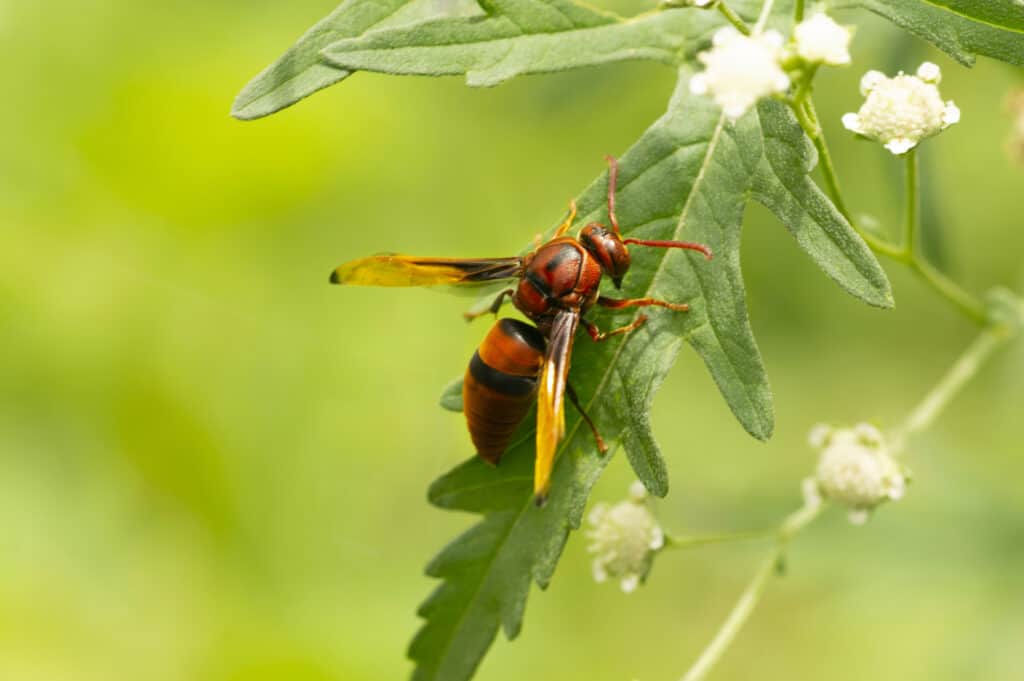
Paper wasps are sometimes called umbrella wasps.
©iStock.com/ePhotocorp
| Paper Wasps | Details |
|---|---|
| Scientific classification | Polistinae (subfamily) |
| Distribution | Worldwide |
| Schmidt’s sting pain index | 3.0 |
| Toxicity | Toxicity levels may depend on individual wasps |
Paper wasps are sometimes called umbrella wasps. The term “paper wasps” is primarily used for the species in the Polistinae subfamily, although people often use it regarding the Stenogastrinaei and Vespinae subfamilies.
The Polistinae paper wasps are known for their very powerful and painful sting. However, they are considered peaceful wasps that attack only if they feel threatened.
Studies have shown that paper wasps with brighter bodies have larger poison glands, too, which indicates that their venom toxicity may depend on their color.
Paper wasp stings cause swelling, redness, itching, and warmth at the sting site.
6. Florida Harvester Ant
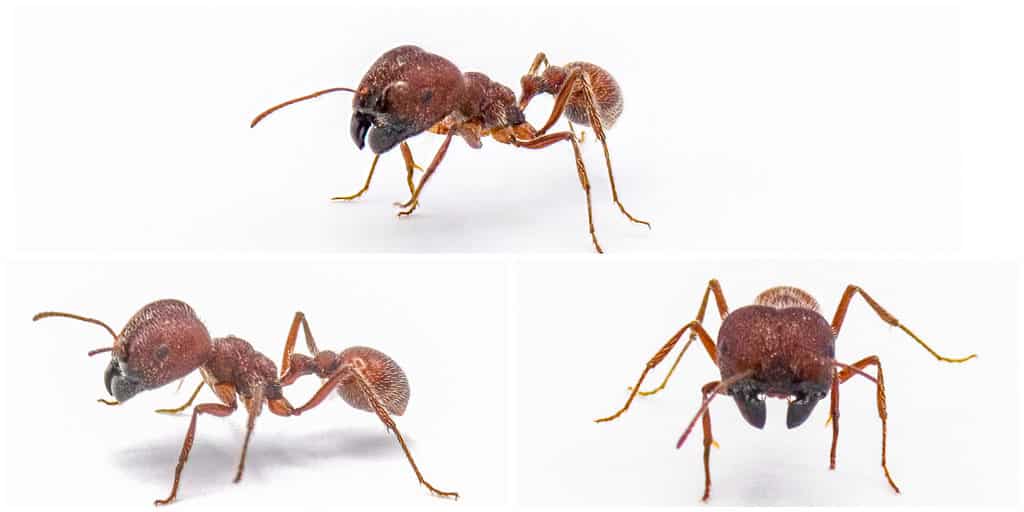
The Florida harvester ant is a species in the Pogonomyrmex genus.
©iStock.com/Dan Rieck
| Florida Harvester Ant | Details |
|---|---|
| Scientific classification | Pogonomyrmex badius |
| Distribution | The east coast of the United States |
| Schmidt’s sting pain index | 3.0 |
| Toxicity | Not toxic enough to cause harm through a single sting |
Florida harvester ant is a species in the Pogonomyrmex genus and lives on the U.S. east coast, being common in Florida sand pine scrub. This species rated 3.0 on Schmidt’s sting pain index.
Florida harvester ant venom is considered toxic, and the neurotoxins in its venom are often compared to those found in snake venoms. However, one Florida harvester ant sting isn’t typically dangerous for humans – harm can only be caused if these insects deliver dozens of stings. Like many other insects, Florida harvester ants aren’t aggressive, so being stung multiple times is unlikely.
However, if you get stung by one, you’ll experience swelling, itching, and redness that can last for a few days.
7. Honeybee
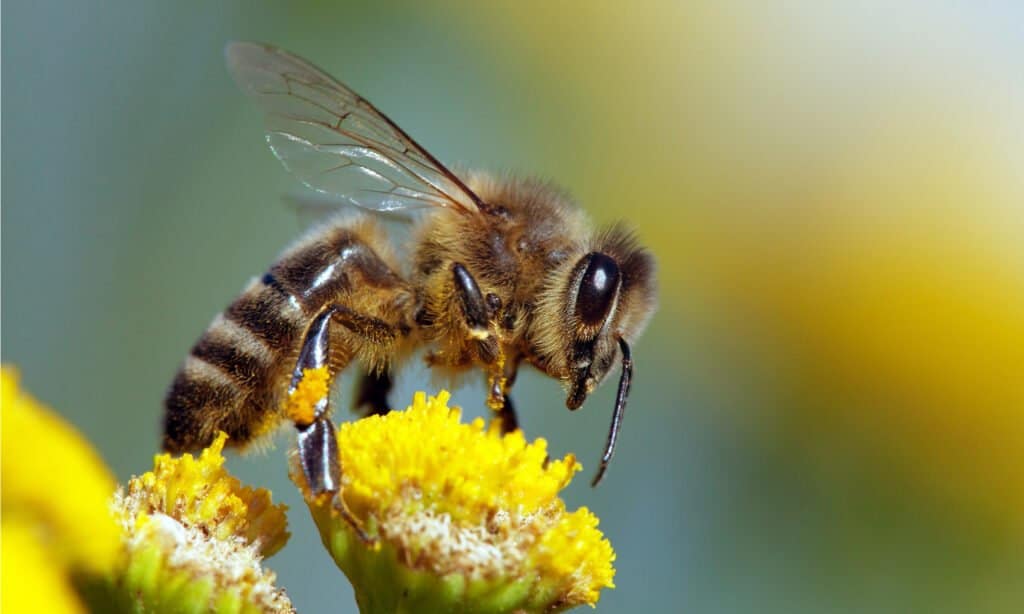
Honeybees are eusocial insects in the
Apisgenus.
©Daniel Prudek/Shutterstock.com
| Honeybee | Details |
|---|---|
| Scientific classification | Apis (genus) |
| Distribution | Native to Africa and Asia; introduced in South America, North America, and Australia |
| Schmidt’s sting pain index | 2.0 |
| Toxicity | Not considered poisonous but can cause allergic reactions |
Honeybees are eusocial insects in the Apis genus. While not all honeybee stings are painful, some rated 2.0 on Schmidt’s sting pain index. Their stings aren’t considered dangerous unless the stung person develops allergic reactions. The pain they cause fades away, but the area may remain swollen, red, and itchy for longer.
On the contrary, honeybee venom is currently scientifically studied to use its properties to control the adverse reactions that appear after bee venom therapy or rheumatoid arthritis.
8. Africanized Bee
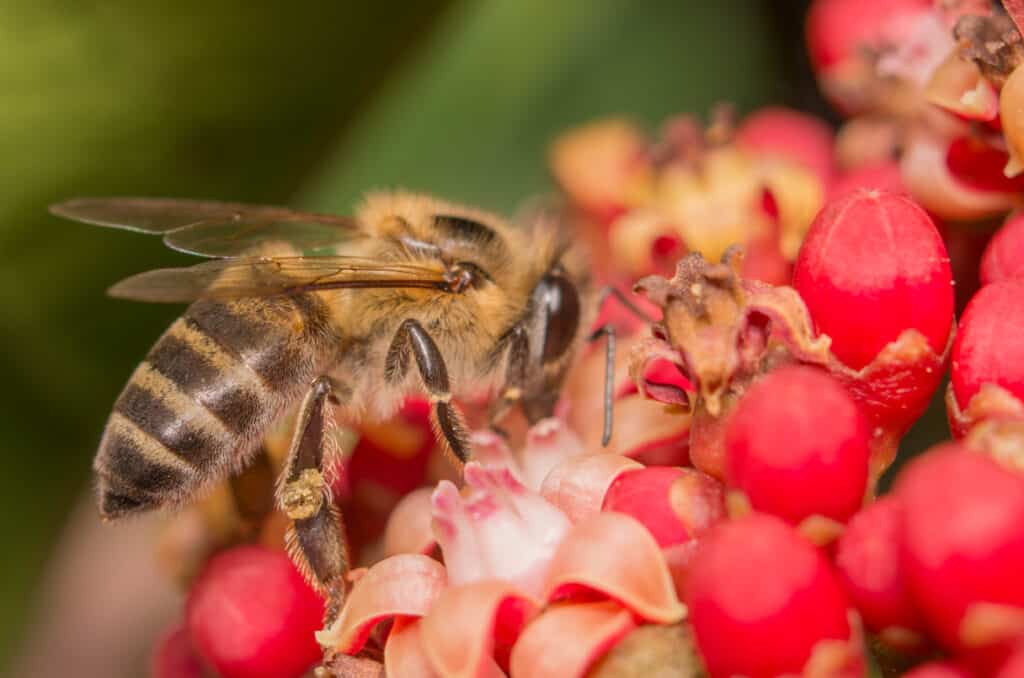
Africanized bees are also known as killer bees.
©Philip Marsden/Shutterstock.com
| Africanized Bee | Details |
|---|---|
| Scientific classification | Apis mellifera |
| Distribution | South and North America |
| Schmidt’s sting pain index | 2.0 |
| Toxicity | Not considered poisonous but may cause allergic reactions |
Africanized bees are also known as killer bees. They are much more aggressive and defensive than other bees and can sting multiple times.
Even if their stings aren’t as painful as those of tarantula hawks, they’re much more dangerous. These bees are known to have killed approximately 1,000 humans, but also horses and other animals. They’re so persevering and aggressive that they can chase people for a quarter of a mile to attack them.
Besides pain, Africanized bee stings cause swelling, redness, itching, and warmth at the sting site.
9. Bumblebee

Bumblebees are social creatures living in colonies.
©iStock.com/skiden
| Bumblebees | Details |
|---|---|
| Scientific classification | Bombus (genus) |
| Distribution | Live in temperate climates at higher latitudes and altitudes; only some species live in very cold climates |
| Schmidt’s sting pain index | 2.0 |
| Toxicity | Not considered poisonous but may cause allergic reactions |
Over 250 bumblebee species are part of the Bombus genus. Bumblebees are social creatures living in colonies.
While their genus ranks 2.0 on Schmidt’s sting pain index, only the queens and the workers can sting. Although they aren’t typically aggressive, bumblebees will sting if their nests are threatened. Moreover, unlike honeybees, bumblebees can sting multiple times.
Humans are occasionally stung by bumblebees, but their stings cause only pain, swelling, redness, and itching unless allergic reactions appear.
10. Yellowjacket

Yellowjackets are predatory social wasps that measure around 0.47 – 0.75 inches long.
©Ernie Cooper/Shutterstock.com
| Yellowjackets | Details |
|---|---|
| Scientific classification | Vespula and Dolichovespula genera |
| Distribution | Worldwide; abundant in the southeastern United States |
| Schmidt’s sting pain index | 2.0 |
| Toxicity | Not considered poisonous but may cause allergic reactions |
Yellowjackets are predatory social wasps that measure around 0.47 – 0.75 inches long. People often mistake them for honey bees, thanks to their coloration. However, here’s what can help you distinguish yellow jackets – they have yellow or white markings, and their bodies aren’t covered with hair.
Using their lance-like stingers, yellow jackets can sting repeatedly. They’re generally more aggressive than other wasps. However, their stings aren’t considered poisonous or dangerous. They’ll usually cause pain, itching, redness, and swelling. On the other hand, a study shows that yellowjacket venom contains three known allergens, which can cause severe allergic reactions.
11. Western Cicada Killer

Western cicada killers are typically 1 – 2 inches long.
©Chuck Holliday / public domain. – License
| Western Cicada Killer | Details |
|---|---|
| Scientific classification | Sphecius grandis |
| Distribution | From Central America to the Western United States |
| Schmidt’s sting pain index | 1.5 |
| Toxicity | Not considered poisonous but may cause allergic reactions |
Western cicada killers are typically 1 – 2 inches long. They can be distinguished from other insects by their amber bodies with yellow rings on the abdomen. Another unique Western cicada killer characteristic is that they are capable of thermoregulation, meaning they can maintain their body temperature at wanted levels.
Since they often make their nests in gardens, sidewalks, and backyards, western cicada killer stings are pretty common. However, females are not generally aggressive and, if left alone, won’t even pay attention to people. Males are considered more aggressive and will sting if grabbed or stepped on.
12. Red Imported Fire Ant

Red imported fire ants are native to Central and South America’s tropical areas.
©NOTE OMG/Shutterstock.com
| Red Imported Fire Ant | Details |
|---|---|
| Scientific classification | Solenopsis invicta |
| Distribution | Central and South America, North America, Australia, New Zealand, Asia |
| Schmidt’s sting pain index | 1.0 |
| Toxicity | Not considered poisonous but may cause allergic reactions |
Red imported fire ants are native to Central and South America’s tropical areas. They’re considered one of the world’s worst invasive species. Red imported fire ants are extremely adaptable creatures able to survive flooding and drought. They are omnivorous and feed on earthworms, arthropods, dead mammals, vertebrates, and seeds. Sometimes they collect the honeydew from other insects.
These insects are so common that they sting around 14 million people per year in the United States only. While their stings aren’t considered dangerous, they can cause mild eczema, pain, burning sensations, and pustules. Moreover, four of the 46 proteins found in their venom are allergens. This indicates that red imported fire ant bites are likely to cause severe allergic reactions.
13. Southern Fire Ant
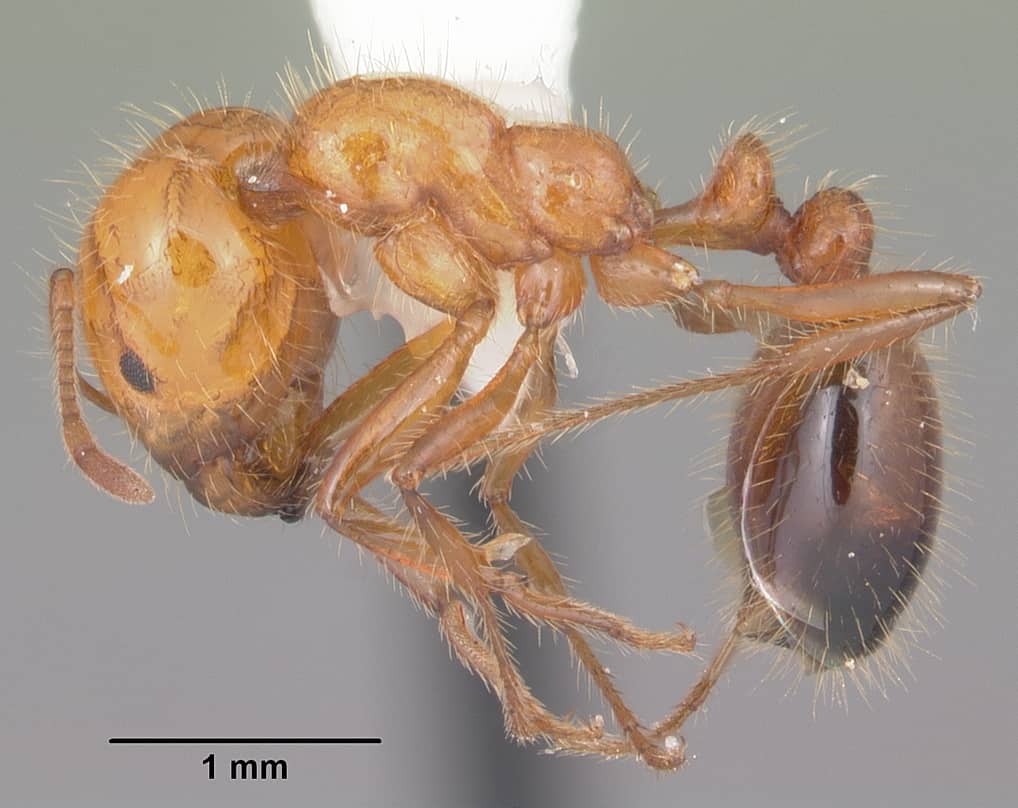
Southern fire ants are native to the southern United States.
©April Nobile / AntWeb.org / CC BY 4.0 – License
| Southern Fire Ant | Details |
|---|---|
| Scientific classification | Solenopsis xyloni |
| Distribution | Southern United States |
| Schmidt’s sting pain index | 1.0 |
| Toxicity | Not considered poisonous but may cause allergic reactions |
Southern fire ants, sometimes called cotton ants or Californian fire ants, are native to the southern United States. They’re found in Tennessee, Arkansas, southern Kansas, Georgia, North Carolina, South Carolina, and California.
These ants are opportunistic feeders who actively look for seeds and insects to collect their honeydew. Their sting is similar to that of red imported fire ants, rating 1.0 on Schmidt’s sting pain index, and isn’t considered poisonous or dangerous unless allergic reactions or other infections occur. However, their stings cause pain and burning sensations that last for around ten minutes, followed by itching that can last for weeks.
Summary of 13 Animals That Sting
Here is a list of 13 animals that sting ranked in order of pain inflicted:
| Rank | Stinging Animal |
|---|---|
| 1 | Bullet Ant |
| 2 | Tarantula Hawk |
| 3 | Warrior Wasp |
| 4 | Velvet Ant |
| 5 | Paper Wasp |
| 6 | Florida Harvester Ant |
| 7 | Honeybee |
| 8 | Africanized Bee |
| 9 | Bumblebee |
| 10 | Yellowjacket |
| 11 | Western Cicada Killer |
| 12 | Red Imported Fire Ant |
| 13 | Southern Fire Ant |
The photo featured at the top of this post is © Jim Lambert/Shutterstock.com
Sources
- Science Direct, Available here: https://www.sciencedirect.com/science/article/abs/pii/S0091674996700933
- National Library of Medicine, Available here: https://www.ncbi.nlm.nih.gov/pmc/articles/PMC3495029/
- Ned Hardy, Available here: https://nedhardy.com/2020/12/23/how-painful-is-a-warrior-wasp-sting/
- Bug Guide, Available here: https://bugguide.net/node/view/1123132/bgimage
Thank you for reading! Have some feedback for us? Contact the AZ Animals editorial team.







